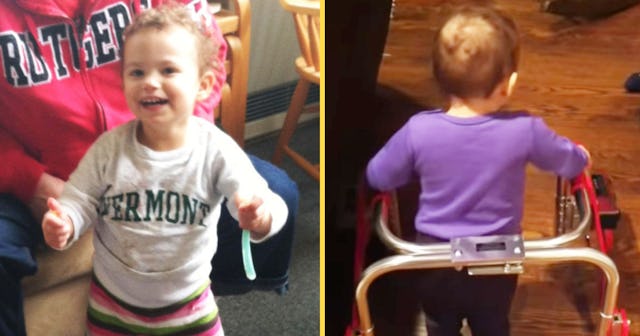Why My Daughter Learning To Walk Was So Incredible

I hate running. I didn’t mind it so much when I played soccer and I forgot I was technically running, but I really despise it when there is nothing to do but run. I try to listen to music but I inevitably find myself stopping on the side of the road, choreographing, and singing to show tunes instead of increasing my heart rate. I should see someone for my unresolved Broadway dreams. I tried in college. It was a good way to counteract all the Wisconsin cheese bread I was eating. My roommate would take me for a spin.
“Just to the mailbox, Leah. You can do it,” she would cheer, her red hair flying in front of me. “You can do it.”
“I mean, we could… or we could stop at the Union and get some ice cream first?”
Running really wasn’t my calling. Which is why it was so surprising one afternoon when I said to my husband randomly, “I will be right back, I need to to go outside.” I threw on a pair of sneakers and temporarily gave myself a time-out from adulting. I just started walking down the street. I resembled an Edward Scissorhands-like figure bumbling down the center of the road, arms extended, no phone, no keys, no sports bra. And because my brain thinks in stories, I found myself Forrest Gump style, suddenly running. I wasn’t tired. I wasn’t bored. I was outside — by myself.
When I clocked it later, I ran more than two miles. And there was a hill. Yes, I was impressed too. I tried to recreate it later that week, but realized the first time was simply an aberration as I just looked at the hill, turned around, and walked home belting “Climb Every Mountain.”
When I returned home, I tried to identify just what it was I was running from. And there it sat — the walker. The fire-engine red, metal contraption I had picked up a month ago to help my daughter learn to walk. She had just received a rare diagnosis of cri-du-chat syndrome, a disorder that is found in 1 in 50,000 births. We aren’t sure if she will ever walk or talk.
At first, I was excited about bringing it home; this would be the tool to help prove the geneticist wrong. The knee height orthotics were beginning to allow her to pull up, but Jordan’s body could not seem to handle its own weight to maintain walking. This contraption was the great solution. However, each time she saw it, she would cry hysterically. I knew I was supposed to push her, but I also knew we both preferred our kitchen dance parties. My husband was much better at working with Jordan; I focused my attention on reorganizing her therapy schedule. I would watch the neighborhood children, half her age, run through the backyard while I measured the distance of our kitchen to see if it could accommodate a wheelchair.
This milestone was far too painful for me. I was not the only one who was frustrated. Our fearless therapists were pulling out all the stops to get her to try. Was her hypotonia not allowing her body to hold her weight because she has so much low tone? Did she cognitively comprehend the motor planning required to take a step? Was her constant wailing during physical therapy a result of fatigue, pain, or frustration? Jordan spent hours with her team, supporting her with hula hoops, banging on drums, and supporting her body with weighted tools.
Courtesy of Leah Moore
On one particularly difficult afternoon, our family trainer came to visit with her dog, Fozzie. The team was interested in trying a new technique and recognized Jordan’s fascination with Fozzie. She was drawn to his fluffy fur and thought he was utterly delightful. It helped that Fozzie was trained and knew exactly what girls like Jordan needed: motivation. The desire to pet Fozzie was enough to get Jordan moving.
Jordan taking her first supported steps will always be for me what An Affair To Remember is for my mother: it doesn’t matter what I am doing, I will always tear up when I think about that day when my two-and-a-half-year-old daughter, who wasn’t supposed to walk, started walking.
A few weeks later, I found myself in a quiet moment.
“I will be right back, I need to to go outside,” I called to my husband.
I strolled down the sidewalk. My thoughts were inundated with pride for my daughter. She checked off the first box on her “won’t be able to do” list. I started to pick up my pace.
If my daughter can learn to walk, I surely can make it to the mailbox.
Courtesy of Leah Moore